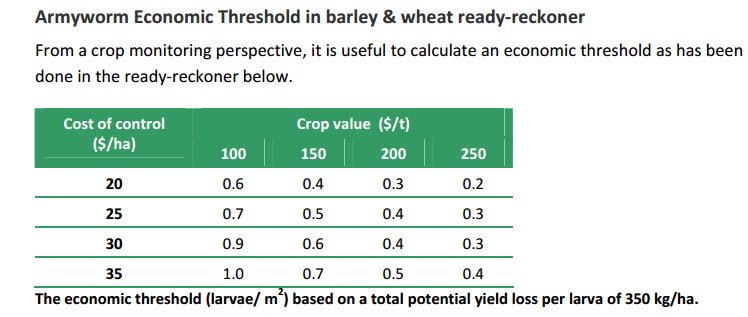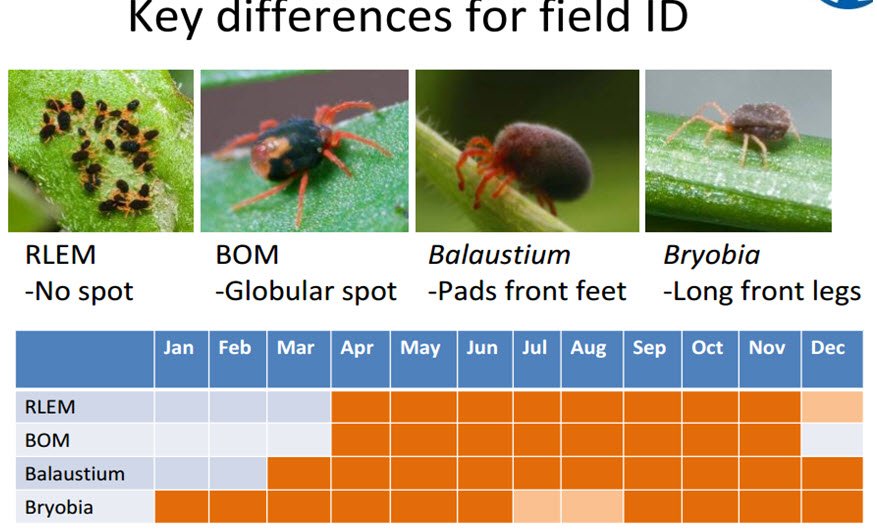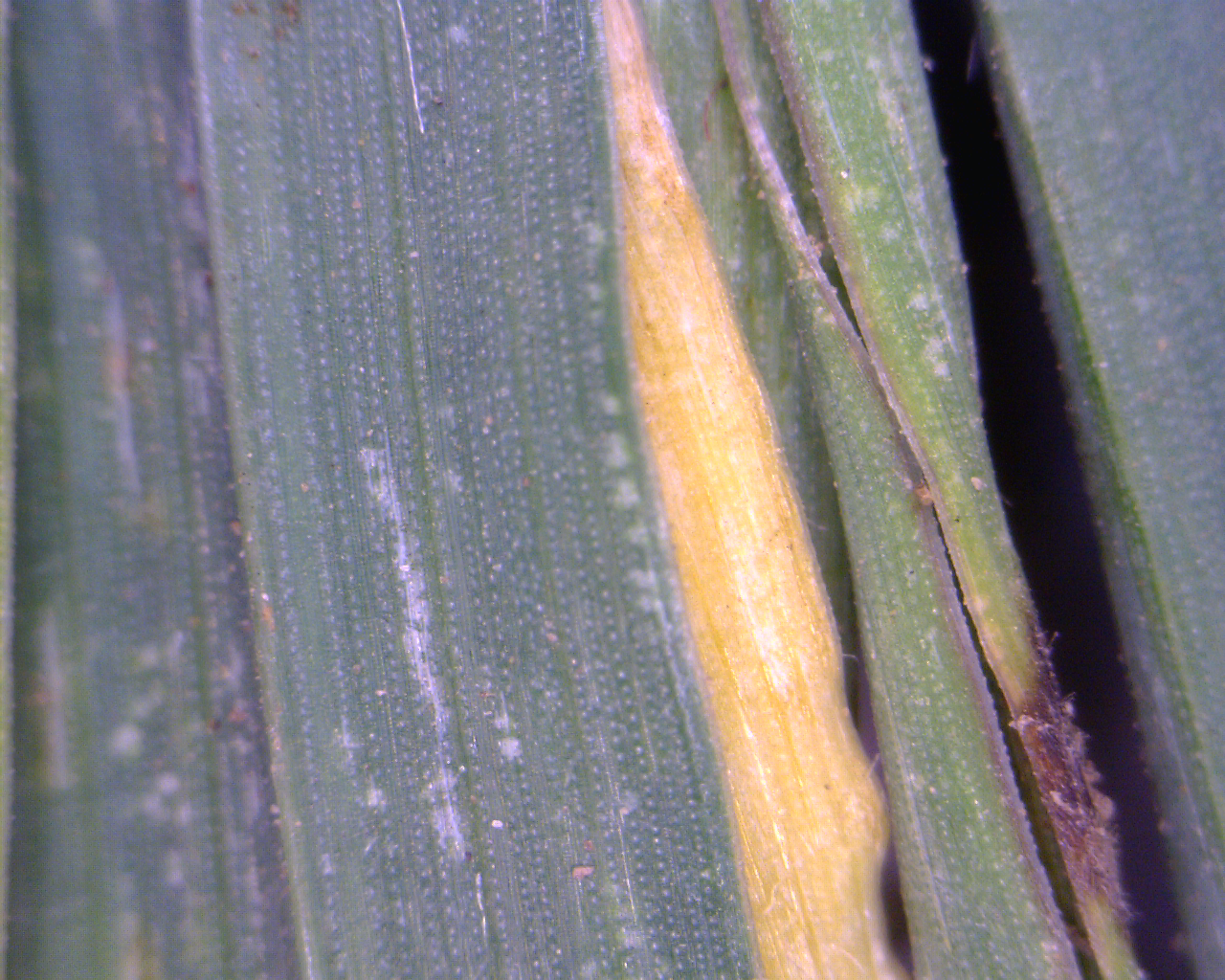Armyworm in barley and wheat.
A number of reports of armyworm in crops have been received over the past couple of weeks. Numbers range from 30 to 50 per square metre (extreme) to a more typical 5 to10 larvae per square metre.
Assessing larval density is done using a sweep net, bucket or beating a section of row into a tray or onto a beatsheet. It is important to check along the row at the base of the plants for larvae sheltering in the soil and stubble. Armyworm are active at night, and tend to shelter on the ground during the day. At higher densities they may be active during the day.
Armyworms are renowned for their damage potential as a result of head lopping in crops that are drying down.
Less is known about the impact of armyworm in crops that are still green, with plenty of leaf in the canopy, and early stages of head emergence and grain fill (Z50 to Z 80).
Considerations in making decisions about the need for, and timing of, control:
Crop stage and condition. Armyworm will feed on green leaf material if it is available. Crops that are drying down, or where leaves have dried early because of disease or herbicide damage are more likely to suffer defoliation of the upper leaves which contribute to yield. Typically, head lopping occurs when larvae feed on the last bit of green material in a plant that is drying off, the stem nodes, resulting in heads being severed. Having said all that, armyworm behaviour can be very erratic, and more or less damage than expected occur for reasons we don’t understand.
Size of the larvae in the crop. Like most caterpillar species, about 80% of the feeding is done in the last instar (large larvae) over a period of 3 to 7 days at current temperatures. Armyworm will be most damaging when large larvae feed on the upper leaves (flag, flag 1, flag 2 etc) or are present when the crop is drying down and most vulnerable to head lopping.
The tables below are a guide to the rate of development of armyworm over the next few weeks (for given temperature range) for Dubbo and Dalby/Moree regions. Because Dubbo is cooler than Moree or Dalby, the development is slower in Dubbo.
Using the tables: For example, a medium (M) larva observed near Moree on 7 September would reach large (L) around 20 September, and then pupate around 29 September.
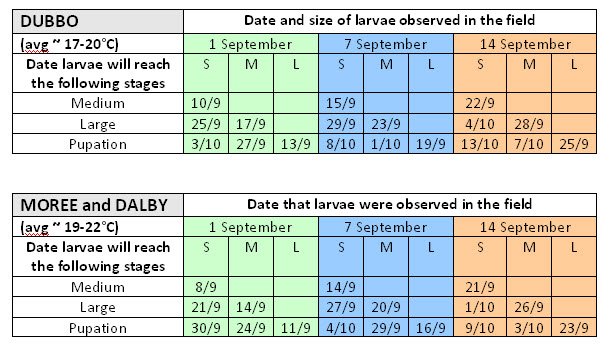
Predictions generated using the DARABUG model developed by Dr Garry McDonald.
Controlling infestations. Armyworm have a range of predators and parasitoids. The parasitoids (flies and wasps) tend to build up in number as the season progresses, and may suppress the population and make the difference between a damaging population and a subthreshold one. In terms of chemical control to prevent crop loss, synthetic pyrethroids are highly effective. For maximum efficacy, consider applying late in the day to maximise contact between the insecticide and the larvae emerging to feed in the canopy at night.
Thresholds to prevent head lopping. It is estimated that one large armyworm larva can lop up to 7 heads per day (armyworms are active mostly at night). At one larva per square metre, that equates to around 70 kg/ha of lost grain per day. A damaging larva may be active for 5 or more days before pupating, giving a conservative potential yield loss of 350 kg/ha.
Use the ready reckoner below to identify the appropriate economic threshold for your situation. The cost of control includes application. The threshold is expressed in terms of the number of larvae per square metre.
Aphids
As the weather warms up aphid populations are becoming more obvious in crops. Corn aphid (Rhopalosiphum maidis) tends to decline in number as the head emerges, but the oat aphid (R. padi) will persist around the base of plants and up the stems onto lower leaves for longer. As temperatures warm up, the activity of natural enemies (parasitoid wasps and predators) also increased rapidly. With the warmer than average temperatures we have, and continue to experience over much of the northern region, natural enemy activity is high and the impact on aphid populations is significant. Look particularly for aphid mummies (evidence of active parasitoid wasps), hoverfly larvae in aphid colonies (look like small maggots) and ladybeetle larvae and adults.
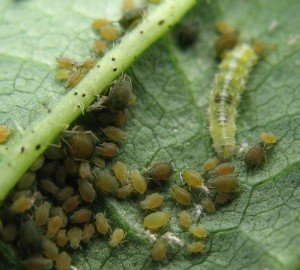
Hoverfly larva feeding cotton aphids (M Miles)
There are no economic thresholds (that take into account costs of control and crop value) for the control of aphids. As a guide, the Northern Grower Alliance trial results suggest an increasing population of more than 10 to 15 aphids per tiller from tillering to head emergence with no sign of beneficial insects may warrant the application of a foliar insecticide.
For more information about aphids refer to the previous posting on Making a decision about control of aphids in winter cereals.
Blue oat mite persisting in winter cereals – cause for concern?
Blue oat mite (BOM) is a pest of seedling winter cereals in the cooler grain growing regions, up as far as Goondiwindi. However, this year large numbers of BOM are being observed in wheat and barley crops through August, which is unusual. The question being asked is whether the mites are likely to cause crop damage that will impact on grain fill.
BOM in advanced cereal crops is not an unusual occurrence in southern Australia where treating these infestations is rare. BOM is relatively tolerant of warm conditions and will persist in crops through until close to harvest as can be seen in the table below which pictures the mite species and their periods of activity in the crops (table courtesy of Paul Umina, cesar).
Control may be warranted if the upper leaves (flag, flag-1) etc are being damaged (silvering and reduction in photosynthetic area) by the mites. Be aware that applying a broadspectrum insecticide to control mites at this late stage may flare aphids and/or armyworm by removing natural enemy populations that may be suppressing these pests.
The table includes another mite species that is worth being aware off too, the Bryobia mite. Bryobia mites include the clover mite and the brown wheat mite, and are distinguishable from other mite species in winter cereals by their elongate front legs. They cause silvering of the leaves, like BOM, but on close inspection the damage is a characteristic series of small ‘dots’.
Why mention Bryobia? Because the clover mite (Bryobia praetiosa) is naturally tolerant of synthetic pyrethroids which are generally used for BOM control. We have heard of at least one instance this season where a mixed population of BOM and Bryobia was sprayed with an SP, resulting in good control of BOM but ongoing leaf damage because the Bryobia were not controlled. A second application of an OP was effective in controlling the Bryobia.
More information on Bryobia can be found by following this link:

